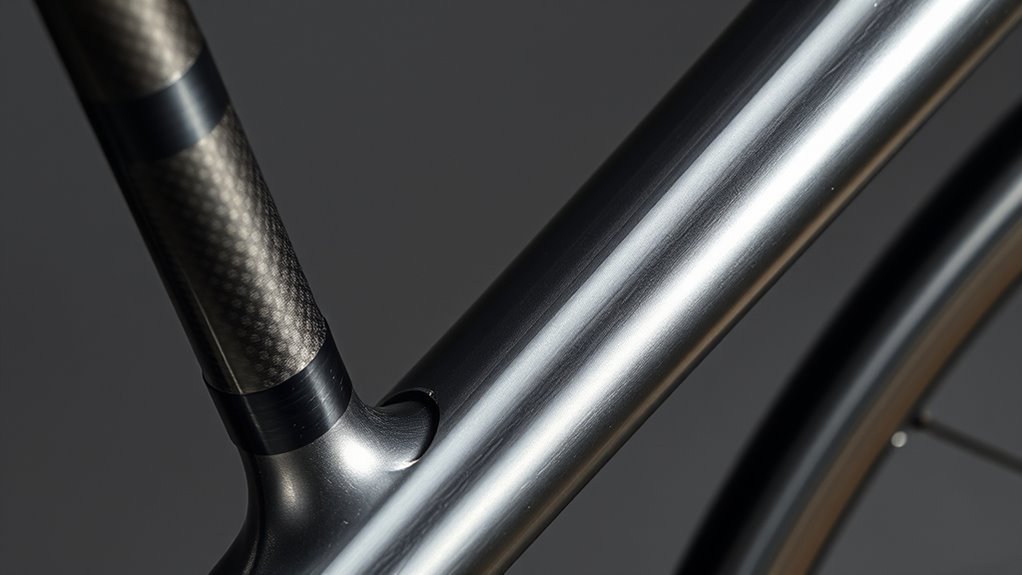Choosing between carbon, alloy, steel, or titanium frames depends on your ride style and budget. Carbon offers a lightweight, stiff, and durable option ideal for racing, but it can be costly and tricky to repair. Alloy frames balance weight and affordability, making them versatile for most riders. Steel is known for longevity and comfort, while titanium provides a lightweight, strong, and corrosion-resistant ride. Continue exploring to discover which material matches your cycling adventures best.
Key Takeaways
- Carbon fiber offers high strength-to-weight ratio and excellent vibration absorption, but has limited repair options.
- Alloy (aluminum) frames balance weight, strength, and affordability, with versatile manufacturing techniques like hydroforming.
- Steel frames are durable, easily repairable, and ideal for touring and commuting due to impact resistance.
- Titanium combines durability and lightness, providing shock absorption and corrosion resistance at a higher cost.
- Manufacturing processes—such as extrusion, forging, and molding—significantly influence each material’s strength, weight, and performance.

Ever wondered what makes a bicycle frame strong, lightweight, or durable? The secret lies in the materials used and how they’re crafted through various manufacturing processes. Frame durability isn’t just about the raw material; it’s also about how that material is shaped, joined, and finished. When you choose a frame, understanding these aspects can help you pick one that suits your riding style and needs. The manufacturing process, such as material shaping, plays a crucial role in determining the final performance and longevity of the frame.
Starting with carbon fiber, it’s known for its exceptional strength-to-weight ratio. Manufacturers produce carbon frames by layering sheets of carbon fabric with resin, then curing them in molds under heat and pressure. This manufacturing process allows for precise control over the fiber orientation, which determines the frame’s strength, stiffness, and flexibility. Because of this, carbon frames excel in providing durability while remaining lightweight. They absorb road vibrations well, making long rides more comfortable. However, carbon can be more delicate in certain impacts, and repair options are limited, so manufacturing quality is vital to guarantee longevity.
Carbon fiber frames combine strength and lightness through precise fiber orientation and resin curing, ensuring durability and ride comfort.
Alloy frames, commonly made from aluminum, offer a good balance of weight, strength, and cost. Aluminum alloys are processed through extrusion or forging, where heated metal is shaped into tubes or other components. Welding or bonding these components creates the frame, with skilled manufacturing techniques ensuring strong joints that withstand regular stresses. Modern alloy manufacturing techniques, like hydroforming, allow for intricate tube shapes that improve strength and reduce weight. While alloy frames may not match carbon’s lightness, they tend to be more affordable and easier to repair, making them suitable for various riding conditions and budgets.
Steel remains a classic choice, prized for its durability and reparability. Steel frames are typically manufactured through tube welding, with processes such as butting—where the tube walls are thick at the ends and thinner in the middle—to reduce weight without sacrificing strength. Steel’s manufacturing processes, including seamless tube production and precise welding techniques, give it high durability and the ability to withstand impacts. Properly treated steel frames resist corrosion and can be repaired easily if damaged. This makes them a favorite among touring and commuter cyclists who need a dependable, long-lasting ride.
Titanium, or Ti, combines the best of both worlds: durability and lightweight performance. Producing titanium frames involves complex manufacturing processes like machining and welding titanium parts, which require specialized skills due to the metal’s properties. Titanium’s manufacturing process ensures a strong, corrosion-resistant frame that’s lighter than steel and more durable than many alloys. Its resilience to fatigue and ability to absorb shocks make it ideal for demanding riders. While more expensive, titanium frames offer unmatched longevity, and their manufacturing quality directly impacts their performance and durability.
Frequently Asked Questions
Which Frame Material Offers the Best Vibration Absorption?
You’ll find that steel offers the best vibration absorption due to its excellent vibration damping properties. Its frame stiffness helps reduce vibrations transmitted through the bike, making for a smoother ride. Steel’s natural damping ability absorbs shocks effectively, preventing them from reaching you. While carbon frames are stiff, they don’t damp vibrations as well, leading to a bumpier experience, so if vibration absorption is your priority, steel is the most suitable choice.
How Do Frame Materials Affect Bike Resale Value?
Your bike’s resale value can skyrocket depending on its frame material, which directly influences durability and weight considerations. High-quality steels and titanium often fetch premium prices because they’re super durable and lightweight, making them highly desirable. Carbon frames, while lighter and high-tech, may depreciate faster if damaged. Alloy frames strike a balance, offering decent durability at a lower cost, appealing to budget-conscious buyers.
Are There Eco-Friendly Options Among Frame Materials?
You can choose eco-friendly bike frame options like biodegradable composites and recycled metals. Biodegradable composites break down naturally, reducing environmental impact, while recycled metals, such as recycled steel or aluminum, lower resource consumption and waste. These sustainable materials help you ride responsibly without sacrificing performance. By opting for eco-friendly frames, you contribute to environmental conservation and support greener manufacturing practices, making your cycling hobby more sustainable and environmentally conscious.
Do Frame Materials Influence Bike Maintenance Needs?
Frame materials substantially influence your bike’s maintenance needs. For example, steel frames require regular rust prevention, while carbon frames are more resistant to corrosion. Frame weight considerations matter, as lighter materials like carbon and Ti reduce wear and tear, lowering maintenance. Additionally, alloy frames offer aesthetic versatility and durability, but may need more upkeep over time. Choosing the right material aligns with your riding style and maintenance preferences.
How Do Frame Materials Impact Bike Compatibility With Accessories?
Your bike’s frame material affects its compatibility with accessories mainly through mount compatibility and mounting points. Steel and alloy frames typically have more dedicated mount points for racks and fenders, making it easier to add accessories. Carbon and titanium frames may have fewer or specialized mount points, so you might need adapters or custom solutions. Always verify your frame’s mount compatibility before purchasing accessories to ensure proper fit and safety.
Conclusion
Choosing the right frame material impacts your ride’s performance and durability. Carbon frames, for example, are 15% lighter than alloy options, making them ideal for speed and agility. Steel offers unmatched strength and comfort, while titanium balances weight and longevity. Whether you prioritize lightweight efficiency or robust durability, understanding these materials helps you make a smarter choice. Ultimately, selecting the right frame can boost your confidence, ensuring every ride feels just right.









